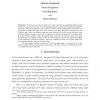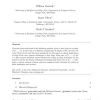87 search results - page 1 / 18 » How Large is the Set of Disjunctive Sequences |
JUCS
2002
13 years 4 months ago
2002
: We consider disjunctive sequences, that is, infinite sequences (-words) having all finite words as infixes. It is shown that the set of all disjunctive sequences can be described...
JCT
2006
13 years 4 months ago
2006
Abstract. Previous research extending over a few decades has established that multiplicatively large sets (in any of several interpretations) must have substantial additive structu...
ECCV
2002
Springer
14 years 6 months ago
2002
Springer
There has been considerable success in automated reconstruction for image sequences where small baseline algorithms can be used to establish matches across a number of images. In c...
SIGIR
2011
ACM
12 years 7 months ago
2011
ACM
Large search engines process thousands of queries per second over billions of documents, making query processing a major performance bottleneck. An important class of optimization...
JCSS
2008
13 years 4 months ago
2008
There has been much work on the following question: given n, how large can a subset of {1, . . . , n} be that has no arithmetic progressions of length 3. We call such sets 3-free....


